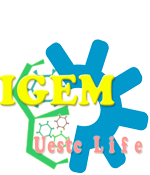Team:UESTC Life/Results and discussion
From 2013.igem.org
| Results and discussion |
|---|
Contents |
TCP Biodegradation Achieved
- Growth of E.coli strain MC1061 transformed DhaA+P2A+HheC and DhaA gene in LB medium with inducer and 5mM TCP respectively, as the substrate was monitored in batch culture. The concentration of the products were confirmed using GC column(AC5). Growth resulted in disappearance of the substrate and simultaneous formation of biomass, 2,3-DCP, epichlorohydrin, chloropropanol, and glycerol. The result was screened by GC analysis. Above the degradation of TCP and the intermediate product 2,3-DCP indicated that multistep biodegradation is working. (Fig.1 and Fig.2). When the E.coli carried DhaA+P2A+HheC gene cultivated in medium with 2,3-DCP, the concentration of epichlorohydrin can be detected(Fig.2). It means 2,3-DCP was degraded to epichlorohydrin. The degradation followed the desired path(refer to project), TCP would be degraded to glycerol in the end. The deficiency of our project was chloropropanol and glycerol couldn’t be detected by our columns. In the future, new columns and new methods will be used to further proof the result.

Fig.1. E.coli strain MC1061 carried DhaA+P2A+HheC gene incubated in LB medium with TCP(5mM) at 30℃. The concentration of TCP and its mediate product 2,3-DCP were measured by GC. 2,3-DCP was degraded at the same time.

Fig.2. E.coli strain MC1061 carried DhaA gene incubated in LB medium with TCP(5mM) at 30℃. The concentration of TCP and its mediate product 2,3-DCP were measured by GC. 2,3-DCP couldn’t be degraded.

Fig.3. E.coli strain MC1061 carried DhaA+P2A+HheC gene incubated in LB medium with 2,3-DCP(5mM) at 30℃. The concentration of 2,3-DCP and its mediate product epichlorohydrin were measured by GC.
γ-HCH Biodegradation and F2A Cleaving Achieved
- Growth of E.coli strain MC1061 transformed LinA+F2A+LinB and LinA gene in LB medium with inducer and 5Mm γ-HCH respectively, as the substrate was monitored in batch culture. The result was screened by GC analysis(Fig.4). Growth resulted in disappearance of the substrate and simultaneous formation of biomass and γ-PCCH et. But available columns is limited that the intermediate product couldn’t be detected. Through SDS-PAGE analysis, F2A could cleave LinA and LinB(Fig.5). LinB would degrade the intermediate product of γ-HCH. So the γ-HCH could be degraded to desired low toxic compounds.

Fig.4. E.coli strain MC1061 carried LinA and LinA+F2A+LinB gene incubated in LB medium with γ-HCH(5mM) at 30℃. The concentration of γ-HCH were measured by GC.

FIG.5. SDS-PAGE analysis. Supernatant and sediment collected after breaking cell. Lane1 and lane2 are blank controls, in the lane3 and lane5 LinA and LinB are solved in the buffer; in the lane7 and lane8, F2A peptide has cleaved LinA and LinB, both of them are solved. The most of protein, LinA+F2A+LinB, is in the sediment as a kind of inclusion body.
P2A Being An Excellent Linker in Chimeric Protein
- As for P2A peptide sequence, it didn’t cleave the DhaA and HheC, and this chimeric protein was linked by P2A peptide. (Fig.6).
- DhaA+P2A+HheC gene were expressed in E.coli strain MC1061. Separating supernatant and sediment of the broken cell liquid and used colorimetric method to detect the activity with TCP and 1,3-DCP.(Fig.7). DhaA+P2A+HheC in supernatant had activity of DhaA and HheC enzymes, while in sediment, there wasn't any activity.
- HheC has a strict structure. Only if four HheC subunits compose together as a tetramer can it catalyze dehalogenation. Measuring the activity of HheC in chimeric protein DhaA+P2A+HheC is an ideal way to detect the effect of P2A peptide. The purified enzymes, HheC and DhaA+P2A+HheC chimeric protein was isolated by AKTA FPLC. Using substrate 1,3-DCP, HheC specific activity was 6.72(U/mg) and the chimeric protein specific activity is 5.28(U/mg). It indicated that the 2A peptide was an excellent linker to compose the two enzymes together.

Fig.6 lane7 and lane8 are blank controls, lane1 and lane3 are the expression of DhaA and HheC gene. In the lane5 and lane6, HheC and DhaA bands can’t be found,there is DhaA+P2A+HheC chimeric protein band, P2A peptide sequence can’t cleave DhaA and HheC. In the sediment, it is DhaA+P2A+HheC inclusion body.


Fig.7 the reaction in buffer(50MmTris-SO3,PH=8.0), after breaking cell, the supernatant and sediment were separated. Blank control was the cell transformed empty vector. Colorimetric method is a way of detecting the concentration of Cl-(refer to protocol). The solved chimeric protein DhaA+P2A+HheC could degrade 1,3-DCP and TCP. The inclusion protein doesn’t have any activity.
Polycistronic co-expression system constructed
- In polycistronic co-expression system, the quantity of HheC was less than DhaA and LinB is less than LinA(Fig.9). Because the gene is fay away from promoter, the expression is less. That is why we want to utilize 2A peptide in prokaryotic system.


Fig.9 (a) In the lane5 and lane6, LinA and LinB are expressed, according to the bands, the quantity of LinB is less than LinA. (b) In the lane1 and lane2, there are both bands of DhaA and HheC, the quantity of DhaA is more than HheC.
Vectors and Parts
 pOHC_00 empty modified pBAD vector
pOHC_00 empty modified pBAD vector
 pOHC_01 LinA at pBAD vector
pOHC_01 LinA at pBAD vector
 pOHC_02 LinB at pBAD vector
pOHC_02 LinB at pBAD vector
 pOHC_03 DhaA at pBAD vector
pOHC_03 DhaA at pBAD vector
 pOHC_04 HheC at pBAD vector
pOHC_04 HheC at pBAD vector
 pOHC_05 LinA+F2A+LinB at pBAD vector
pOHC_05 LinA+F2A+LinB at pBAD vector
 pOHC_06 DhaA+P2A+HheC at pBAD vector
pOHC_06 DhaA+P2A+HheC at pBAD vector
 pOHC_07 LinA+RBS+LinB at pBAD vector
pOHC_07 LinA+RBS+LinB at pBAD vector
 pOHC_08 DhaA+RBS+HheC at pBAD vector
pOHC_08 DhaA+RBS+HheC at pBAD vector
Parts we submitted
BBa_K1199041 LinA at pSBC31
BBa_K1199042 LinB at pSBC31
BBa_K1199043 DhaA31 at pSBC31
BBa_K1199044 HheC/W249P at pSBC31
BBa_K1199045 LinA+F2A+LinB at pSBC31
BBa_K1199046 DhaA31+P2A+HheC/W249P at pSBC31
BBa_K1199047 LinA+RBS+LinB at pSBC31
BBa_K1199048 DhaA31+RBS+HheCW249P at pSBC31
Future Work
● Assaying the change of every intermediate product
● Improve the activity of DhaA and HheC
● Decreasing inclusion body
● Using P2A to create other chimeric protein
 "
"

